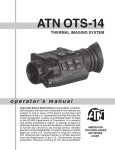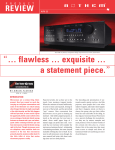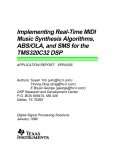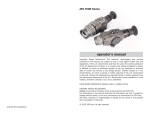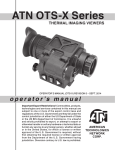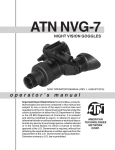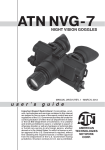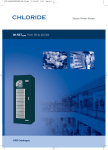Download ATN OTS-15 operator`s manual
Transcript
ATN OTS-15 THERMAL IMAGING SYSTEM ATN ots-15 operator’s manual (Rev. 1, NOVEMBER 2010) o p e r a t o r ’s m a n u a l Important Export Restrictions! Commodities, products, technologies and services contained in this manual are subject to one or more of the export control laws and regulations of the U.S. Government and they fall under the control jurisdiction of either the US Department of State or the US BIS-Department of Commerce. It is unlawful and strictly prohibited to export, or attempt to export or otherwise transfer or sell any hardware or technical data or furnish any service to any foreign person, whether abroad or in the United States, for which a license or written approval of the U.S. Government is required, without first obtaining the required license or written approval from the Depar tment of the U.S. Government having jurisdiction. Diversion contrary to U.S. law is prohibited. Register your product warranty online at www.atncorp.com/warranty The information in this manual furnished for information use only, is subject to change without notice, is not to be construed as a commitment by ATN Corp. ATN Corp. assumes no responsibility or liability for any errors or inaccuracies that may appear in this book. © 2010 ATN Corp. All right reserved. SAFETY SUMMARY STUDY CAREFULLY THIS MANUAL BEFORE TURNING ON AND OPERATING THIS PRODUCT. CAUTIONS The ATN OTS-15 thermal imaging systems are precision optical-electronic instruments and requires careful handling. To provide safe use of the systems the following instructions should be observed: • Do not dismantle the device. • Keep the device clean; protect it from moisture, sharp temperature drops and shocks. • Be careful not to touch the glass surfaces. If you put fingerprints on, or contaminate the glass surfaces, use only clean and soft materials to clean it. • Do not leave the device in on position during stops in operation. • Remove the battery from the device for the period of storage. Caution : This product contains natural rubber latex which may cause allergic reactions a WARNING Do not permanently attach the camera to dynamic-mount applications that continuously transmit vibration (such as on vehicles or heavy machinery). WARNING Do not point the camera directly at any high-intensity objects that you must not view with your eyes (such as the sun or a welding arc). If you do, you will damage the camera. WARNING Operating OTS outside of its specified operating temperature range or voltage range can cause permanent damage and will void the warranty. WARNING Use the power button to turn the camera off before you remove power (remove batteries or disconnect external power supply). WARNING OTS operates over a wide operating temperature range (-20°C to +50°C). Not all AA batteries are specified over this same temperature span. Check the manufacturer’s specifications of your selected battery to verify the valid temperature range. WARNING Do not use any battery other than a CR-123A lithium battery. DO NOT use any battery(ies) providing a (combined) voltage greater than 3.0 volts. WARNING Do not install batteries of different types (lithium with lithium-ion rechargeable). All batteries must be of the same type. WARNING Always replace ALL 2 batteries. If you install new batteries with used batteries, the result may be dangerous. b WARNING Do not replace batteries in a possibly explosive environment, such as a gas station (or any place where you must turn off your vehicle engine). If you do, sparks can cause an explosion. WARNING Remove the batteries before you store the camera for extended periods (2 weeks or more). WARNING Do not carry batteries in pockets containing metal objects such as coins, keys, etc. Metal objects can cause the batteries to short circuit and become very hot. In the case of lithium batteries, a short circuit could cause them to explode. WARNING Observe battery manufacturer’s guidelines for safe handling and proper disposal of batteries. eqUipment limitatiOnS • The OTS detector spectral band (7 to 14 mkm) provides a better penetration through smoke, smog, dust, water vapor etc. • Infrared radiation does not travel through glass and therefore the monocular does not sense objects if they are behind a glass window. c TABLE OF CONTENTS i pg. SECTION I. INTRODUCTION 1.1 General Information 1.1.1. Scope 1.1.2.Reports 1.1.3. Storage 1.1.4. Warranty Information 1.2. Description and Data 1.2.1. Description 1.2.2.OTS Standard Components 1.2.3.OTS Optional Components 1.2.4.Specifications 1.2.5.Mechanical Functions 1.2.6.Optical Functions 1.2.7. Electrical Functions 1-1 1-2 1-2 1-2 1-2 1-3 1-5 1-5 1-7 1-9 1-10 1-11 1-12 1-12 SECTION II. ASSEMBLY AND PREPARATION 2.1. Preparation 2.1.1.Preparation for use 2.1.2.Examination for operation 2.1.3. Setting 2.2.Assembly 2.2.1.External power source 2.2.2.Output 2.2.3.2X Afocal Lens 2-1 2-2 2-2 2-3 2-3 2-5 2-5 2-5 2-6 SECTION III. OPERATION 3.1. General Information 3.1.1. General 3.1.2. Controls and Indication 3.2.Operating procedure 3.2.1. Turning On 3.2.2.Focusing 3-1 3-2 3-2 3-2 3-4 3-4 3-4 3.2.3.Color modes 3.2.4.Brightness 3.2.5.Color Mode Button 3.2.6.Shut Down Operations 3-5 3-5 3-6 3-6 SECTION IV. MAINTENANCE INSTRUCTIONS 4.1. Preventive Maintenance Checks and Services (PMCS) 4.1.1. Purpose of PMCS 4.1.2. Frequency of Performing PMCS 4.2.Troubleshooting 4.2.1. General 4.2.2.Troubleshooting Procedures 4.3.Maintenance Procedures 4.3.1. Scope Maintenance 4.3.2.Cleaning Procedures 4.3.3.Preparing for Extended Storage 4-2 4-2 4-2 4-6 4-4 4-4 4-6 4-6 4-6 4-7 Appendix A. Spare Parts List A-1 For Technical Information 4-1 INFO-1 ii iii SECTION I introduction 1-1 1.1 General Information 1.1.1. Scope This manual contains instructions for use in operating and maintaining the ATN OTS-15 thermal imaging systems. Throughout this manual, the ATN OTS-15 will be referred to as the scope or OTS. 1.1.2. Reports Reports from the user on recommendations for improvements are encouraged. Send reports to the address below. American Technologies Network Corp. 1341 San Mateo Avenue South San Francisco, CA 94080 (800) 910-2862 (650) 989-5100 (650) 875-0129 fax [email protected] www.atncorp.com 1.1.3. Storage Storage of OTS should be done in the factory packing and after a thorough PMCS as outlined in Section 4.1. of this manual. This will ensure the scope remains in mission ready condition during storage. Battery should be stored separately from the scope. The scope should not be placed on the floor, in any area exposed to high temperatures or direct sunlight. Presence of acid and alkaline vapor, as well as of other aggressive admixtures in the air is unacceptable. 1-2 1.1.4. Warranty Information One Year Product Warranty This product is guaranteed to be free from manufacturing defects in material and workmanship under normal use for a period of 1 (one) years from the date of purchase. In the event a defect that is covered by the foregoing warranty occurs during the applicable period stated above, ATN, at its option, will either repair or replace the product, and such action on the part of ATN shall be the full extent of ATN’s liability, and the Customer’s sole and exclusive remedy. This warranty does not cover a product (a) used in other than its normal and customary manner; (b) subjected to misuse; (c) subjected to alterations, modifications or repairs by the Customer of by any party other than ATN without prior written consent of ATN; (d) special order or “close-out” merchandise or merchandise sold “as-is” by either ATN or the ATN dealer; or (e) merchandise that has been discontinued by the manufacturer and either parts or replacement units are not available due to reasons beyond the control of ATN. ATN shall not be responsible for any defects or damage that in ATN’s opinion is a result from the mishandling, abuse, misuse, improper storage or improper operation, including use in conjunction with equipment which is electrically or mechanically incompatible with or of inferior quality to the product, as well as failure to maintain the environmental conditions specified by the manufacturer. This warranty is extended only to the original purchaser. Any breach of this warranty shall be waived unless the customer notifies ATN at the address noted below within the applicable warranty period. The customer understands and agrees that except for the foregoing warranty, no other warranties written or oral, statutory, expressed or implied, including any implied warranty of merchantability or fitness for a particular purpose, shall apply to the product. All such implied warranties are hereby and expressly disclaimed. Limitation of liability ATN will not be liable for any claims, actions, suits, proceedings, costs, expenses, damages or liabilities arising out of the use of this product. Operation and use of the product are the sole responsibility of the Customer. ATN’s sole undertaking is limited to providing the products and services outlined herein in accordance with the terms and conditions of this Agreement. The provision of products sold and services performed by ATN to the Customer shall not be interpreted, construed, or regarded, either expressly or implied, as being for the benefit of or creating any obligation toward any third party of legal entity outside ATN and the Customer; ATN’s obligations under this Agreement extend solely to the Customer. ATN’s liability hereunder for damages, regardless of the form or action, shall not exceed the fees or other charges paid to ATN by the customer or customer’s dealer. ATN shall not, in any event, be liable for special, indirect, in- 1-3 cidental, or consequential damages, including, but not limited to, lost income, lost revenue, or lost profit, whether such damages were foreseeable or not at the time of purchase, and whether or not such damages arise out of a breach of warranty, a breach of agreement, negligence, strict liability or any other theory of liability. Product warranty registration In order to validate the warranty on your product, ATN must receive a completed Product Warranty Registration Card for each unit or complete warranty registration on our website at www.atncorp.com. Please complete the included form and immediately mail it to our Service Center: ATN Corporation, 1341 San Mateo Avenue, South San Francisco, CA 94080. Obtaining warranty service To obtain warranty service on your unit, End-user must notify ATN service department by calling 800-910-2862 or 650-989-5100 or via e-mail [email protected] to receive a Return Merchandise Authorization number (RMA). When returning please take or send the product, postage paid, with a copy of your sales receipt to our service center, ATN Corporation at the address noted above. All merchandise must be fully insured with the correct postage; ATN will not be responsible for improper postage or, missing or damaged merchandise during shipment. When sending product back, please clearly mark the RMA# on the outside of the shipping box. Please include a letter that indicates your RMA#, Name, Return Address, reason for service return, Contact information such as valid telephone numbers and/or e-mail address and proof of purchases that will help us to establish the valid start date of the warranty. Product merchandise returns that do not have an RMA listed may be refused or a significant delay in processing may occur. Estimated Warranty service time is 10-20 business days. End-user/customer is responsible for postage to ATN for warranty service. ATN will cover return postage/shipping after warranty repair to end-user/customer only if product is covered by aforementioned warranty. ATN will return product after warranty service by domestic UPS ground and/or domestic mail. Any other requested, required or international shipping method the postage/shipping fee will be the responsibility of the end-user/customer 1-4 1.2.Description and Data 1.2.1. Description A. Purpose The OTS-15 is a thermal system intended for law enforcement, military and commercial uses. It is built around state-of-the-art uncooled thermal imaging technology, highly integrated DSPbased electronics and a compact, lightweight system. The OTS-15 thermal bi-ocular provides excellent image quality which is unaffected by lights or shadows that seriously hamper the image quality of image intensifier night vision. Total darkness, camouflage or bright lights will not affect the sensitivity of these units. The ATN OTS-15’s superior performance, compact size, ease of use and cost efficiency make it the perfect thermal imaging device. Figure 1-1. ATN OTS-15 Thermal Imaging Systems 1-5 B. Features OTS has the following important features: • High resolution digital thermal imaging • Compact, light weight and durable housing • High Quality optics • Video output • Video/Image polarity selection • Adjustable display brightness • Adjustable eyepiece diopters • Adjustable lens focus • Digital zoom • Power input capability • Waterproof 1-6 1.2.2. OTS Standard Components The OTS-10 standard components are shown in Figure 1-2 and presented in Table 1-1. 2 1 3 4 5 6 7 8 Figure 1-2. OTS-10 Standard Components Table 1-1. OTS-10 Standard Components ITEM DESCRIPTION QTY 1 Scope 1 2 Soft Carrying Case 1 3 Hard Storage Case 1 4 Lens Tissue 1 5 Lithium Battery CR123A 2 6 RCA Video/power Adapter 1 7 Operator’s Manual 1 8 Neck Lanyard 1 1) Scope The monocular thermal imaging device. 2) Soft Carrying Case A protective bag used for storing of OTS and accessories. 1-7 3) Hard Storage Case A protective case used for shipping/storing OTS and accessories. 4) Lens Tissue Uses for cleaning of lenses surface. 5) Lithium Battery CR123A Two CR123A lithium batteries used to power the unit. 6) RCA Video/power adapter RCA Video/power adapter used for video transmission and to connect external power sources. 7) Operators Manual Provides equipment description, use of operator controls and preventative maintenance checks and service. 1-8 8) Neck Lanyard Used to prevent damage due to dropping the scope. 1.2.4. specificaTIONS The following tables provide information pertaining to the operational, electrical, mechanical, optical and environmental characteristics for the sights. Table 1-4. Specifications ITEM Magnification Objective Focal Length FOV Focus Range Focus Adjustment DATA 6X (12X digital) 50 mm 5.5° x 4.1° from 5m to infinity Manual Exit Pupil 5 mm Eye Relief 16 mm Detector Type Spectral Response Pixels Pixel Size Angular Resolution, mrad Thermal Sensitivity Range to Detect a Human Output Format Display Display Format Brightness Adjustment Contrast Adjustment Uncooled Microbolometer 7-14 μm 160 x 120 30 x 30 μm 0.2 < 0,1°C 750 m Analog PAL / NTSC Color OLED matrix SVGA, 852 x 600 pxl Manual Automatic Power Supply 2 x 3V, 123A type Start-Up Time < 3 sec Operating Time w/one battery pack External Power Supply Operating Temperature Range 4 hrs DC 6V, 500 mA from -20°C to +50°C 1-9 ITEM DATA Waterproof Yes, up to 10m submersion Dimensions 139 x 110 x 58 mm Weight (w/batteries) 0.39 kg * ATN reserves the right to change the above specifications at any time without notice 1.2.5. Mechanical function The mechanical adjustments of the OTS-15 sights allow for physical differences between individual operators using the system. The scope functions include the switchboard, refresh button, universal connector, bi-ocular eyepiece with diopter adjustment ring, focusing ring, battery compartment cover. The mechanical controls are identified in Figure 1-4. UNIVERSAL CONNECTOR WITH CAP bi-ocular EYEPIECE EYEPIECE DIOPTER ADJUSTMENT RING FOCUSING RING LENS SWITCHBOARD ON-OFF BUTTON BATTERY CAP Figure 1-4. OTS-15 Mechanical Controls 1-10 refresh BUTTON 1.2.6. Optical function The optical functions include an objective lens, thermal imaging detector and bi-ocular eyepiece. Infrared energy is emitted proportionally to the temperature of an object. The warmer the object, the more energy it emits. The infrared energy from the objects is focused by the optics, onto an infrared detector. The information from infrared detector is passed to electronics for image processing. The signal processing circuitry translates the infrared detector data into an image that can be viewed on the built-in OLED display. The image is observed through an eyepiece by operator. 1.2.7. electrical function The electronic circuit is powered by replaceable batteries - either two 3.0 Volt lithium battery (CR123A). OTS-15 can be to connect to an external 6 VDC/ 1 A power supply used the video cable. Power from the batteries or external power supply is supplied to the components through the OFF-ON switch button. 1-11 1-12 SECTION II assembly and preparation 2-1 2.1.preparation 2.1.1. Preparation for Use This chapter contains the information necessary to prepare the scope for operation. This includes unpacking, examination for damage, and battery installation. A. Unpacking The following steps must be accomplished prior to each mission where the sight is used. 1. Open carrying case, remove the scope and check contents for completeness. 2. Inspect the scope for obvious evidence of damage to optical surfaces, body, eyecups, operation buttons, etc. Ensure that all optical surfaces are clean and ready for use. Clean with lens paper. B. Attachment of Neck Lanyard To prevent damage due to dropping the scope, use the neck lanyard included with your equipment. C. Installation of Battery WARNING The lithium battery contains sulfur dioxide gas under pressure. Do not heat, puncture, disassemble, short circuit, attempt to recharge or otherwise tamper with the batteries. Turn off equipment if battery compartment becomes unduly hot. If possible, wait until the batteries have cooled before removing them. If you inhale sulfur dioxide, seek medical attention. The OTS will operate with two CR123A Lithium battery type. CAUTION Make certain the operation switch is in the off position before installing batteries. 2-2 Install CR123A Lithium batteries as follows. 1. Remove the battery cap by turning it counterclockwise. 2. Check to ensure the o-ring is present. If not, replace it. 3. Observe polarity, as indicated on the outside of the battery compartment, and insert two 3.0 Volt CR123A Lithium battery into the battery compartment, plus (+) end first (Figure 2-1). 4. Replace battery cap by pushing and turning it clockwise. Tighten it firmly to ensure a watertight seal. Figure 2-1. Install batteries 2.1.2. examination for operation Before getting started make sure to follow these steps: 1.Push ON-OFF button on the scope. 2.Make sure that the luminance in ocular is present. 3.Observe the scene, and adjust the diopter and/or lens for optimal image clarity. 2-3 2.2. assembly 2.2.1. external power source Warning When the unit is to be powered with external sources, first make sure the batteries have been taken out. As an external power source, a standard network controller with outer voltage of 6V and current of over 0.5A can be applied. To connect an external source recommend to use a 6 mm standard double-pole socket in the way the positive contact is the central contact. Use the video cable to connect an external 6 VDC/ 1 A power supply to the OTS-10. Connect an external power supply to the monocular as follows: 1.Remove the batteries. 2.Remove the protective cap from the monocular output connector socket. 3. Attach the video cable to the output connector socket. 4. Attach the power jack socket of the cable to a 6 VDC/ 1 A power supply. Note 1. The external power supply plug must have a 6 mm OD contact with center pin positive. 2. Avoid a sudden removal of power source: use the power button «ON/OFF» to turn the monocular off before you remove batteries or disconnect external power supply. 3.Replace the protective cap on the monocular output connector socket after disconnecting the cable. 2.2.2. video output The OTS incorporates a sealed Connector used for video transmission and to connect external power sources. Video Cable attaches the scope to the video facilities for video recording or video 2-4 transmission (1) to the external display, though at the same time it accepts the external power supply(2). Connect the monocular to an external video display/recorder and to an external power supply as follows: 1.Remove the batteries. 2.Remove the protective cap from the connector socket. 3. Attach the video cable to the OTS output connector socket. 4. Attach the RCA plug of the video cable to a compatible jack on an external video display/recorder, or extension cable. 5. Attach the power jack socket of the cable to a 6 VDC/ 1 A power supply. Warning When the unit is to be powered with external sources, first make sure the batteries have been taken out. 2 1 Figure 2-3. Attaching Video Cable 2-5 2-6 SECTION III OPERATION 3-1 3.1.General information 3.1.1. General This section contains instructions for operation of OTS. The function of controls and indicators is explained. CAUTION The OTS scope is a precision electron-optical instrument and must be handled carefully at all times. 3.1.2. Controls and indication The OTS scope is designed to adjust for different users and corrects for most differences. The controls for the scope are shown or described in Figure 3-1 and Tables 3-1. 6 1 2 3 7 5 4 Figure 3-1. Controls 11 12 8 9 10 Figure 3-2. OTS-15 Screen Indications 3-2 Table 3-1. Controls and Indication CONTROLS AND ITEMS INDICATORS 1 ON-OFF Button FUNCTIONS Controls scope power. To turn the unit on and off press the button . 2 Zoom Button Digital 2x magnification On. 3 Polarity Button Switch from white hot to black hot (only is functional in B&W mode) 4 BRIGHTNESS Buttons Adjustment of the output image brightness. 5 refresh Button Maintains an optimum thermal image. 6 Objective Lens Focus Focuses objective lens. Adjusts for sharpest image of viewed object. 7 Diopter Adjustment Focuses eyepiece lens without the need for Rings glasses. Adjusts for sharper image of intensifier screen. 8 EI Indicator Automatic Electronic Iris (EI) mode indicator. 9 Temperature Showing the actual measured temperature at the center of the display. 10 Units Showing the units of temperature measuring. 11 Scale Scale of the temperature indicator. 12 Bar Dynamic temperature indicator. 3-3 3.2.operating procedure 3.2.1. Turning ON Open the objective lens cover. The objective lens cover protects the monocular from inadvertent exposure to extremely high levels of radiant flux. Never leave the monocular with the objective lens cover off. To turn the unit on press the button labeled ON/OFF. After a warm-up time of approximately 3 seconds, video of the thermal scene appears. NOTE During the warm-up time, a logo comes into view on the monocular display. Next the thermal image replaces the logo. NOTE The image you see will have a yellow tint. The yellow tint provides better contrast and resolution over black and white images. Figure 3-3. Switchboard of OTS 3.2.2. FOCUSING To focus the scope you need to adjust the diopter first. The scope has an adjustable eyepiece with a range of +2 to -6 diopter. Simply turn the diopter clockwise until it stops. Then concentrate on any object and slowly turn the diopter back counter clockwise until the grain in the image is sharp. Then rotate the eyecup to accommodate use over the left or right eye. You scope has ability to focus either long range or short. Focus the front lens to rotate it until the image and the grain are both sharp. 3-4 EYEPIECE DIOPTER ADJUSTMENT RING FOCUSING RING Figure 3-4. Focus Adjustment NOTE The front lens should be readjusted for viewing objects at different distances. Rotate the focusing ring clockwise for far focus, counterclockwise for near focus. 3.2.3. POLARITY modes «POLARITY» button switches the direct display mode into the reverse one, i.e. hot-white/cold-black into hot-black/cold-white mode. If the polarity is hot-white, the image will be with hotter objects displayed as white, and the rest of the image displayed as black, and vice versa: with hotter objects displayed as black, if polarity is black-hot (only is functional in B&W mode). 3.2.4. Brightness Press «BRIGHTNESS +» and «BRIGHTNESS –» buttons for brightness adjustment. Each short push of the buttons «BRIGHTNESS +» or «BRIGHTNESS –» raises or lowers the display brightness, correspondingly, in stepwise way. NOTE Levels 1 to 8 range from full dim to full bright. 3-5 3.2.5. refresh button Degradation of the image (image blurring) is caused by charge accumulation on the detector array. Use the REFRESH button (Figure 1-4) to maintain an optimum thermal image. During this refresh, the video will freeze for approximately 0.5 second. NOTE While performing very frequent Refreshes can provide the best possible image quality but also can decrease substantially the battery life. 3.2.6. Shut Down Operations To finish the work, perform the following: 1. Use the ON-OFF button to turn the scope off. 2.Replace the protective cover on the objective lens. 3. Disconnect the cable (if it present). 4. Replace the protective cap on the monocular output connector socket. 5.Return the monocular and the cable to the case. 3-6 SECTION IV maintenance instructions 4-1 4.1.Preventive Maintenance Checks and Services (PMCS) 4.1.1. Purpose of PMCS PMCS is performed daily when in use to be sure that the sight is ready at all times. Procedures listed in Table 4-1 are a systematic inspection of OTS that will enable you to discover defects that might cause the sight to fail on a mission. 4.1.2. Frequency of performing PMCS The frequency of performing PMCS is as follows: A. Daily when the sight is in use. B. When it is removed from the case for any reason. Table 4-1. Preventive Maintenance Checks and Services 4-2 SEQ. NO. ITEM TO CHECK CHECKING PROCEDURE NOT FULLY MISSION CAPABLE IF: 1 Completeness Inventory items by means of comparing with the data specified in this manual. Items missing. 2 Sight Body Inspect for missing screws or connector cap. Screws or connector cap missing. 3 Front Lens Cap Inspect for cuts, tears and dirt. Clean as required. Cap torn or cut. 4 Battery Compartment Check for corrosion, springs tension, cap damaged or retainer broken. Check O-ring for cuts or damage. Springs corroded or damaged. Retainer broken. Cap or O-ring damaged or missing. 5 Function Buttons Check for operation (without battery). Switch inoperative. Knob missing. SEQ. NO. ITEM TO CHECK CHECKING PROCEDURE NOT FULLY MISSION CAPABLE IF: 6 Lenses Inspect for cleanliness, scratches, chips or cracks. Clean as required. Chipped, cracked or if scratches hinder vision through the sight. 7 Objective Lens Check to ensure the objective lens is not loose. Objective lens loose. Check to ensure: 8 9 Focus Ring Rubber Eye-cup - the focus ring cannot be moved along the sight body; Focus ring able to move along sight body. - there is free rotation of the focus ring (more than 3/4 turn). Focus ring cannot be rotate. Inspect for cuts or tears. Rubber Eye-cup torn or cut. AFTER CHECKING PROCEDURES 10 Replace protective covers on the lenses. Remove the battery. Return the scope and all accessories to the storage case. 4-3 4.2.Troubleshooting 4.2.1. General This section contains information for locating and removal most of the OTS operating troubles which may occur. Each malfunction for an individual component or assembly is followed by a list of tests or inspections that will help determine probable causes and corrective action to take. Perform the tests/inspections and corrective actions in the order listed. This manual cannot list all possible malfunctions that may occur, or all tests or inspections and corrective actions. If a malfunction is not listed (except when malfunction and cause are obvious), or is not corrected by listed corrective actions, contact to the service center. 4.3.2. Troubleshooting Procedures Troubleshooting procedures are listed in Table 4-2. Table 4-2. Troubleshooting Procedures PROBLEM Image is absent Cannot achieve the sharp image of the object. 4-4 PROBABLE CAUSE CORRECTIVE ACTION Battery is missing or improperly installed. Insert battery or install correctly. Battery is dead. Replace battery. Battery contact surfaces or contact springs dirty or corroded. Clean the contact surfaces with a pencil eraser and/or alcohol and cotton swabs. Objective and output lenses dirty. Clean thoroughly the lenses surfaces. Damaged optical components. Send the sight to the service center. PROBLEM The brightness of the image on the screen is low. PROBABLE CAUSE CORRECTIVE ACTION The batteries has a low voltage. Replace the batteries. Factory alignment broken. Send the scope to the service center. 4-5 4.3.Maintenance Procedures 4.3.1. Scope Maintenance The OTS maintenance consists of external inspection of its components for serviceability, cleaning and installation of the standard and optional accessories. Maintenance instructions covered elsewhere in this manual (PMCS, troubleshooting, etc.) are not repeated in this section. CAUTION The OTS is a precision electron-optical instrument and must be handled carefully at all times to prevent damage. 4.3.2. Cleaning Procedures A. Cleaning the scope 1. Gently brush off any dirt from the sight body using only a clean soft cloth. 2.Moisten the cloth with fresh water and gently wipe the external surfaces (except lenses). 3. Dry any wet surfaces (except lenses) with another dry and clean soft cloth. 4. Using lens brush, carefully remove all loose dirt from the lenses. 5. Slightly dampen a cotton swab with ethanol and lightly and slowly wipe the lenses. Clean the glass surfaces by circular movements from the centre to the edge, not touching the lens holder and changing cotton swab after each circular stroke. Repeat this step until the glass surfaces are clean. B. Cleaning of accessories Clean accessories with a soft brush (cloth) and soap and water as required. CAUTION Dry thoroughly each item before replacing into the storage case. 4-6 4.3.3. Preparing for Extended Storage To prepare the OTS for extended storage, perform the following: 1. Check the monocular for serviceability as outlined in item 4.1 of this manual. 2.Remove the batteries. 3. Clean the monocular and accessories. 4. Replace all items in the case. 4-7 APPENDIX A spare PARTS LIST The Spare Parts List is an illustrated catalog of main parts and assemblies completing the OTS system. Therefore, in case of failure of any part or assembly User could replace it by ordering the corresponding part/assembly from the Spare Parts List. The amount and assortment of the spare parts needed should be arranged with each contract individually. 4 5 3 2 6 7 1 Figure A-1. OTS-10 Scope Table A-1. OTS-10 spare parts list PART NO. A-1 DESCRIPTION FIG. ITEM QTY AT 88842.000 Scope A1 AT 88931.001 Lens Cap A1 1 1 AT 88931.002 Focusing Ring A1 2 1 AT 88941.001 Housing A1 3 1 PART NO. DESCRIPTION FIG. ITEM QTY AT 88931.006 Eyepiece A1 4 1 AT 88931.007 Rubber Eye-cup A1 5 2 AT 88931.008 Connector Cap A1 6 1 AT 88931.009 Battery Cap A1 7 1 CR123A type battery A1 1 2 4 5 1 3 6 Figure A-2. OTS-15 Accessories Table A-2. OTS-15 Accessories parts list PART NO. DESCRIPTION FIG. ITEM QTY Accessories 1 A2 AT 88932.000 Soft Case A2 1 1 AT 88933.000 RCA Video/power adapter A2 2 1 AT 88934.000 Storage Case A2 3 1 AT 88936.000 Neck Lanyard A2 4 1 AT 88937.000 Operator’s Manual A2 5 1 AT 88938.000 Lens Tissue A2 6 1 A-2 For Technical Information ATN Corp. 1341 San Mateo Avenue South San Francisco, CA 94080 (800) 910-2862 (650) 989-5100 tel. (650) 875-0129 fax www.atncorp.com [email protected] INFO-1 A-4 For customer service and technical support, please contact American Technologies Network Corp. North American Office 1341 San Mateo Avenue, South San Francisco, CA 94080 phone: 800-910-2862, 650-989-5100; fax: 650-875-0129 European Office The following countries can use our toll free number: 00 800 9102-8620 Austria, France, Germany, Holland, Italy, Spain, Sweden, Switzerland For other countries, please use 38 048-7770214 or 38 048-7770345 www.atncorp.com ©2010 ATN Corporation












































